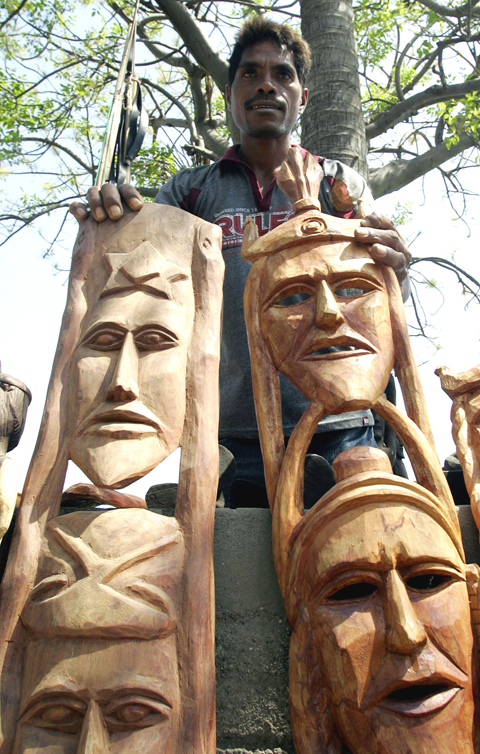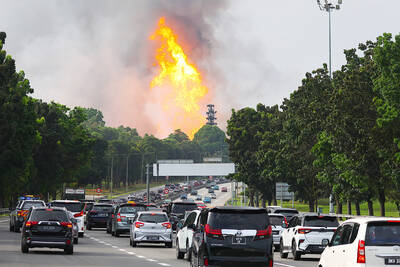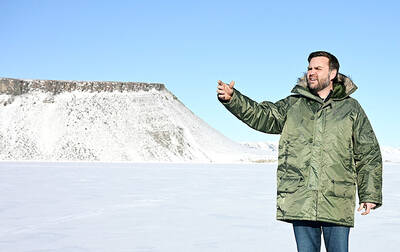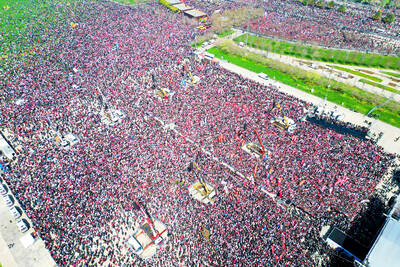East Timor’s struggle against Indonesian occupation may soon become a tidy earner, with the government considering plans to promote key sites of the 25-year fight for independence as part of a tourism campaign.
A former Portuguese colony, East Timor was invaded in 1975 by Indonesia, but a secessionist movement soon emerged, led by Xanana Gusmao, who is now the country’s prime minister, and Jose Ramos-Horta, its president.
Gusmao spent much of occupation either in jail or on the run, often hiding with guerrilla fighters in East Timor’s mountainous terrain, while Ramos-Horta lived in exile, campaigning for independence.

PHOTO: REUTERS
An estimated 180,000 died during the occupation, including 1,000 the UN says were killed during the bloody 1999 vote for independence.
But tourists regard East Timor’s turbulent past as a draw card, said Japanese tour guide, Noriko Inaba, as she escorted a Japanese tour group to Dili’s Santa Cruz cemetery, where more than 200 East Timorese were killed in 1991 when Indonesian troops fired on mourners, an event known as the Dili massacre.
“It’s an historical place because of the tragedy,” she said. “This is one of the things we came to see here.”
The cemetery’s caretaker, Joao da Costa, said tourists often visit the site and take photos.
“If more people came from overseas, maybe we could develop faster,” he said.
East Timorese Tourism Minister Gil da Costa Alves says the government wants tourism to contribute more toward economic growth in a country that is one of the poorest in Asia and dependent on oil and gas for the bulk of state finances.
While there are serious obstacles, including poor infrastructure and a shortage of hotel rooms, he sees scope to promote the historic sites, beaches, and wildlife.
“We have this opportunity for historical tourism, for people who are interested in those sites that are part of our history,” he said.
“Even the cave where Xanana was in hiding, this is a place we can promote and other places around the country where our leaders were hiding up in the hills,” he said.
About 19,000 people visited East Timor last year, up from about 12,000 in 2006, when tourists stayed away because of political strife. Now that the situation was more stable, Alves said he hoped that in five years’ time East Timor could attract as many as 200,000 tourists a year.
However, Loro Horta, an East Timor analyst based at Singapore’s Nanyang Technological University was skeptical.
“The entire country has less than 700 [hotel] rooms. Right now it’s already difficult to get rooms in Dili,” said Horta, who is also the son of the president.
“So 200,000 a year, that’s something like 700 a day. How exactly are they flying there and where are they going to stay?” he asked.
Horta said more affordable flights to Dili, a bigger airport and more reliable power supply were also needed before East Timor could compete with Indonesia’s Bali island as a tourist destination.
“I really hope I’m wrong, but we will be lucky if we can get 50,000 a year by 2014,” he said.
Alves said new a infrastructure plan — including a US$600 million airport redevelopment, construction of new boutique hotels and the improvement of basic infrastructure such as roads — would boost tourism in future.
He said a broader tourism campaign would be aimed at the Australian and Japanese markets and would involve advertising and competitions such as a recently launched fishing tournament and the Tour de Timor bicycle race that took place earlier this year.
Today, conditions in dusty downtown Dili are still very basic and poverty is rife, but the underdevelopment means that many beaches, diving spots, and bushland tracts are relatively pristine.
Last year, the government opened the Nino Konis Santana national park in an effort to protect many of its animal and plant species while providing a new attraction for tourists.
“Our strategy is to focus on the things that make East Timor different to surrounding destinations,” Alves said.

A fire caused by a burst gas pipe yesterday spread to several homes and sent a fireball soaring into the sky outside Malaysia’s largest city, injuring more than 100 people. The towering inferno near a gas station in Putra Heights outside Kuala Lumpur was visible for kilometers and lasted for several hours. It happened during a public holiday as Muslims, who are the majority in Malaysia, celebrate the second day of Eid al-Fitr. National oil company Petronas said the fire started at one of its gas pipelines at 8:10am and the affected pipeline was later isolated. Disaster management officials said shutting the

US Vice President J.D. Vance on Friday accused Denmark of not having done enough to protect Greenland, when he visited the strategically placed and resource-rich Danish territory coveted by US President Donald Trump. Vance made his comment during a trip to the Pituffik Space Base in northwestern Greenland, a visit viewed by Copenhagen and Nuuk as a provocation. “Our message to Denmark is very simple: You have not done a good job by the people of Greenland,” Vance told a news conference. “You have under-invested in the people of Greenland, and you have under-invested in the security architecture of this

Japan unveiled a plan on Thursday to evacuate around 120,000 residents and tourists from its southern islets near Taiwan within six days in the event of an “emergency”. The plan was put together as “the security situation surrounding our nation grows severe” and with an “emergency” in mind, the government’s crisis management office said. Exactly what that emergency might be was left unspecified in the plan but it envisages the evacuation of around 120,000 people in five Japanese islets close to Taiwan. China claims Taiwan as part of its territory and has stepped up military pressure in recent years, including

UNREST: The authorities in Turkey arrested 13 Turkish journalists in five days, deported a BBC correspondent and on Thursday arrested a reporter from Sweden Waving flags and chanting slogans, many hundreds of thousands of anti-government demonstrators on Saturday rallied in Istanbul, Turkey, in defence of democracy after the arrest of Istanbul Mayor Ekrem Imamoglu which sparked Turkey’s worst street unrest in more than a decade. Under a cloudless blue sky, vast crowds gathered in Maltepe on the Asian side of Turkey’s biggest city on the eve of the Eid al-Fitr celebration which started yesterday, marking the end of Ramadan. Ozgur Ozel, chairman of the main opposition Republican People’s Party (CHP), which organized the rally, said there were 2.2 million people in the crowd, but